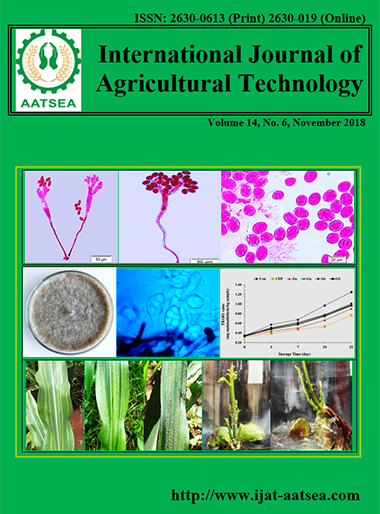The Study of Natural Agents for Fungal Inhibition on the Surface of Medium Density Fibreboard during Construction
Main Article Content
Abstract
The growth of fungi on the medium density fibreboard (MDF) were investigated for interior and furniture work that affect to health and construction plan.The encountered fungi were controlled by natural agents and evaluated according to Laboratory Manual for Wood decaying Fungi Protection, Thailand Foresty Department. Poisoned food technieque was used to test and resulted to wood vinegar was most effective treatment to inhibit Aspergillus sp. with a growth inhibition of 21.75% and spore inhibition of 94.76% which the ED50 value was 9.30 µg/ml. Chitosan and nano-elicitor significantly inhibited the growth of tested fungi. It was able to inhibit fungal growth of 35.75% and 34.25%, respectively, while the spore inhibition was 45.06% and 47.86%, respectively. To control Fusarium sp., Chitosan was the most effective bioactive compoung which inhibiting the growth of 38.50% and the spore inhibition was 47.86%. It was found that the tested natural products could not inhibited of colony growth of Penicillium spp. but it can inhibit the spore production. Nano-elicitor was foung to inhibit the spore production of 58.41% which the ED50 value was 4.51µg/ml. Finally, the testing on pieces of medium density fibreboard showed that the fungi colony occurred at every replicate of inoculation control. While MDF pieces were sprayed with 1000 ppm of biological inhibitiors shown no symptom and less fungal colony on its surface.
Article Details

This work is licensed under a Creative Commons Attribution-NonCommercial-NoDerivatives 4.0 International License.
References
Allan, C. R. and Hadwigei, L. E. (1979). The Fungicidal Effect of Chitosan on Fungi of Varying Cell Wall Composition, Experimental mycology. 3:285-287.
Guerrero, J. P., Jansson, H. B., Salinas, J. and Llorca L.V. L. (2007). Effect of chitosan on hyphal growth and spore germination of plant pathogenic and biocontrol fungi, journal of Applied Microbiology. 104:541-553.
LIN, H. C., Murase, Y., Shiah, T. C., Hwang G. S., Chen P. K. and Wu, W. L. (2007). Application of Moso Bamboo Vinegar with Different Collection Temperatures to Evaluate Fungi Resistance of Moso Bamboo Materials, journal of the Faculty of Agriculture, Kyushu University. 53:107-113.
Mungkunkamchaoa, T., Kesmala, T., Pimratch, S., Toomsan, B. and Jothityangkoon, D. (2013). Wood vinegar and fermented bioextracts: Natural products to enhance growth and yield of tomato (Solanum lycopersicum L.), Scientia Horticulturae. 154:66-72.
Park, S. I., Stan, S. A., Daeschel, S. A. and Zhao, Y. (2005). Antifungal Coatings on Fresh Strawberries (Fragaria × ananassa) to Control Mold Growth During Cold Storage, Journal Of Food Science. 70.
Promachotikool, Y., Likitvarachod, K., Krajai, P. and Kumtago, N. (2015). Laboratory manual for wood decaying fungi protection, The Royal Forest Department, Thailand.
Soytong, K., Kanokmedhakul, S., Kukongviriyapan, V. and Isobe, M. (2001). Application of Chaetomium species (Ketomium) as a new broad spectrum biological fungicide for plant disease control: A review article. Fugal Diversity. 7:1-15.
Tann, H. and Soytong, K. (2017). Bioformulations and nano productfrom Chaetomium cupreum CC3003 to control leaf spot of rice var. Sen Pidao in Cambodia. International Journal of Plant Biology. 8.


